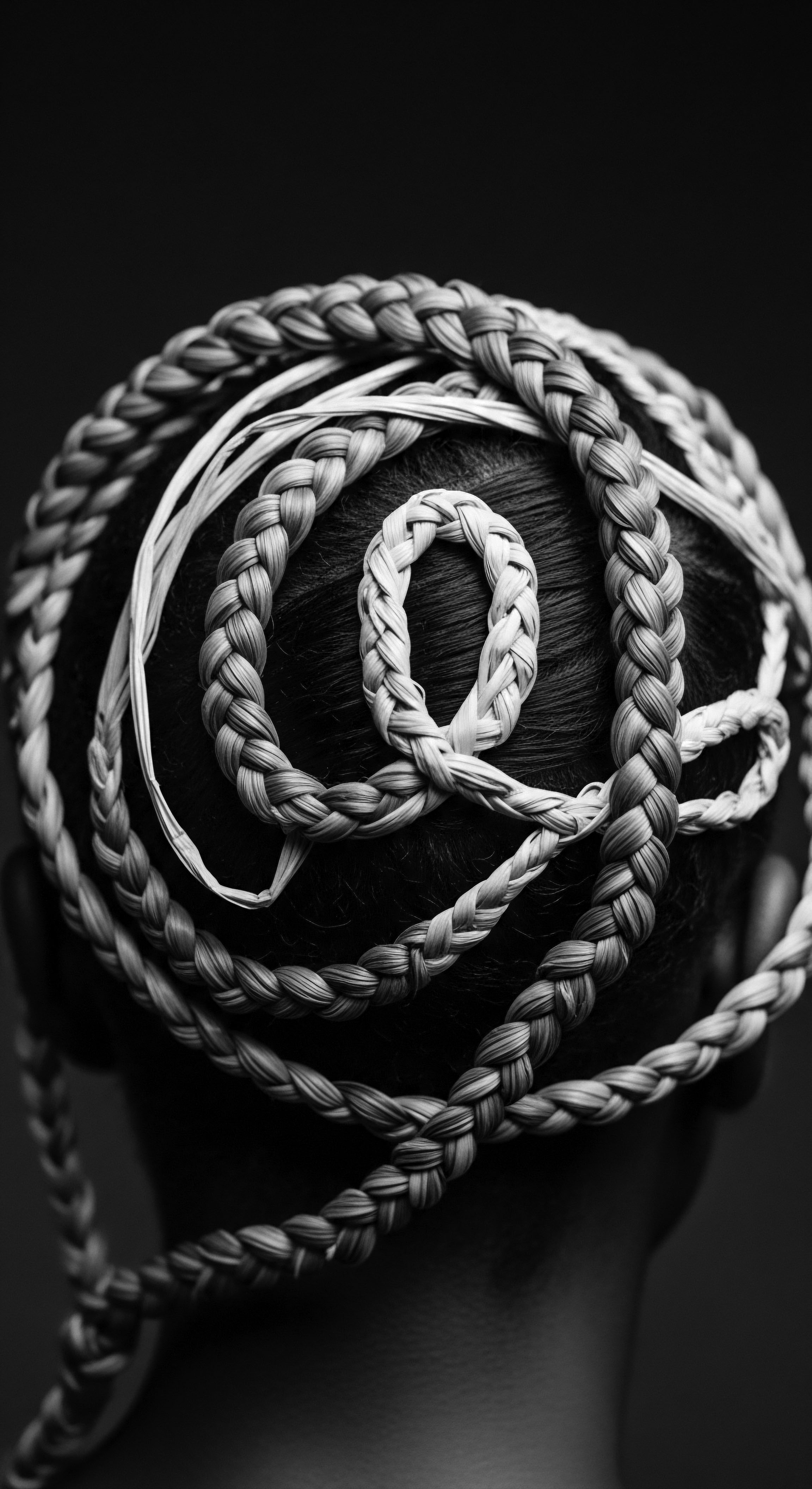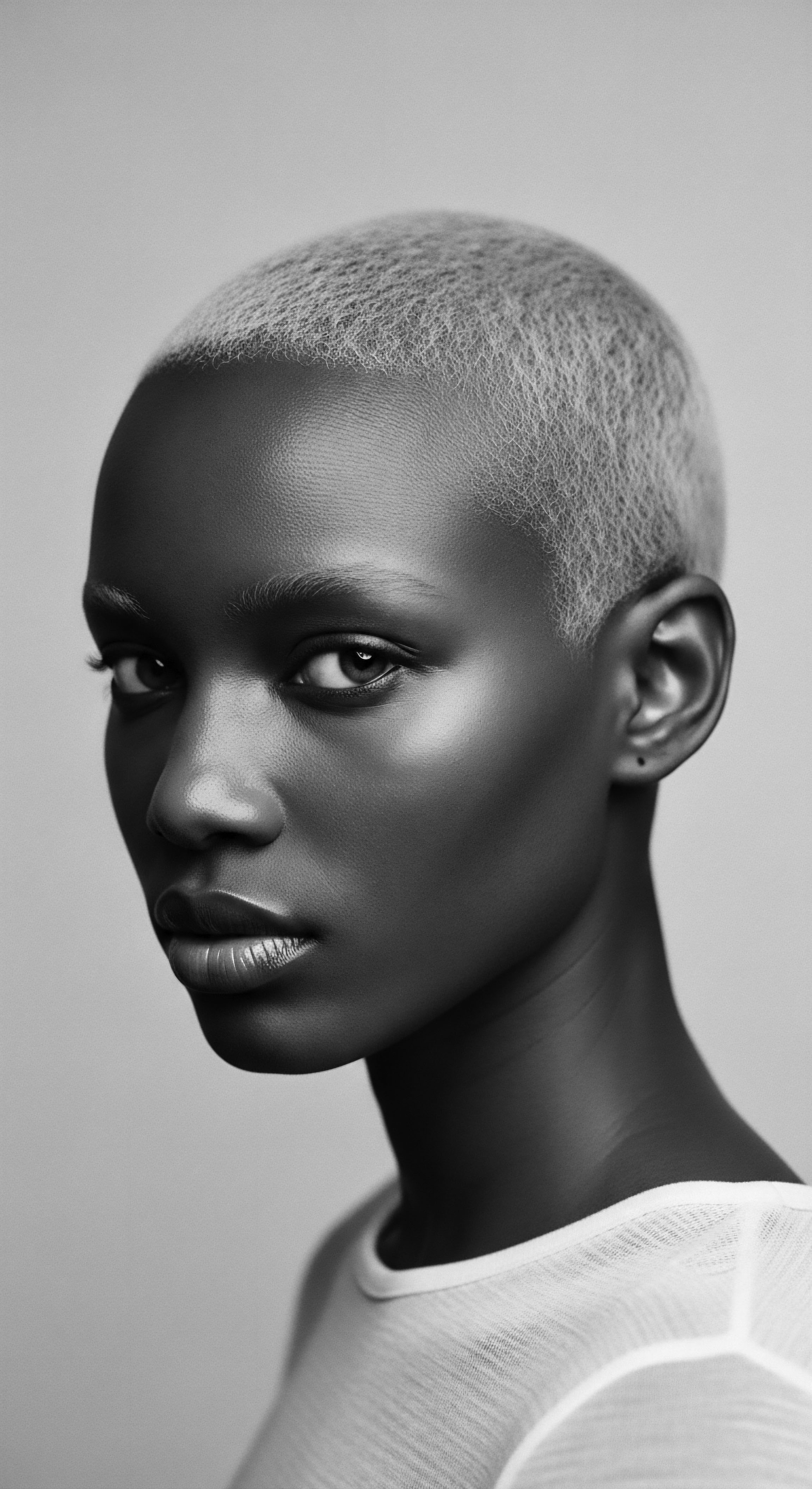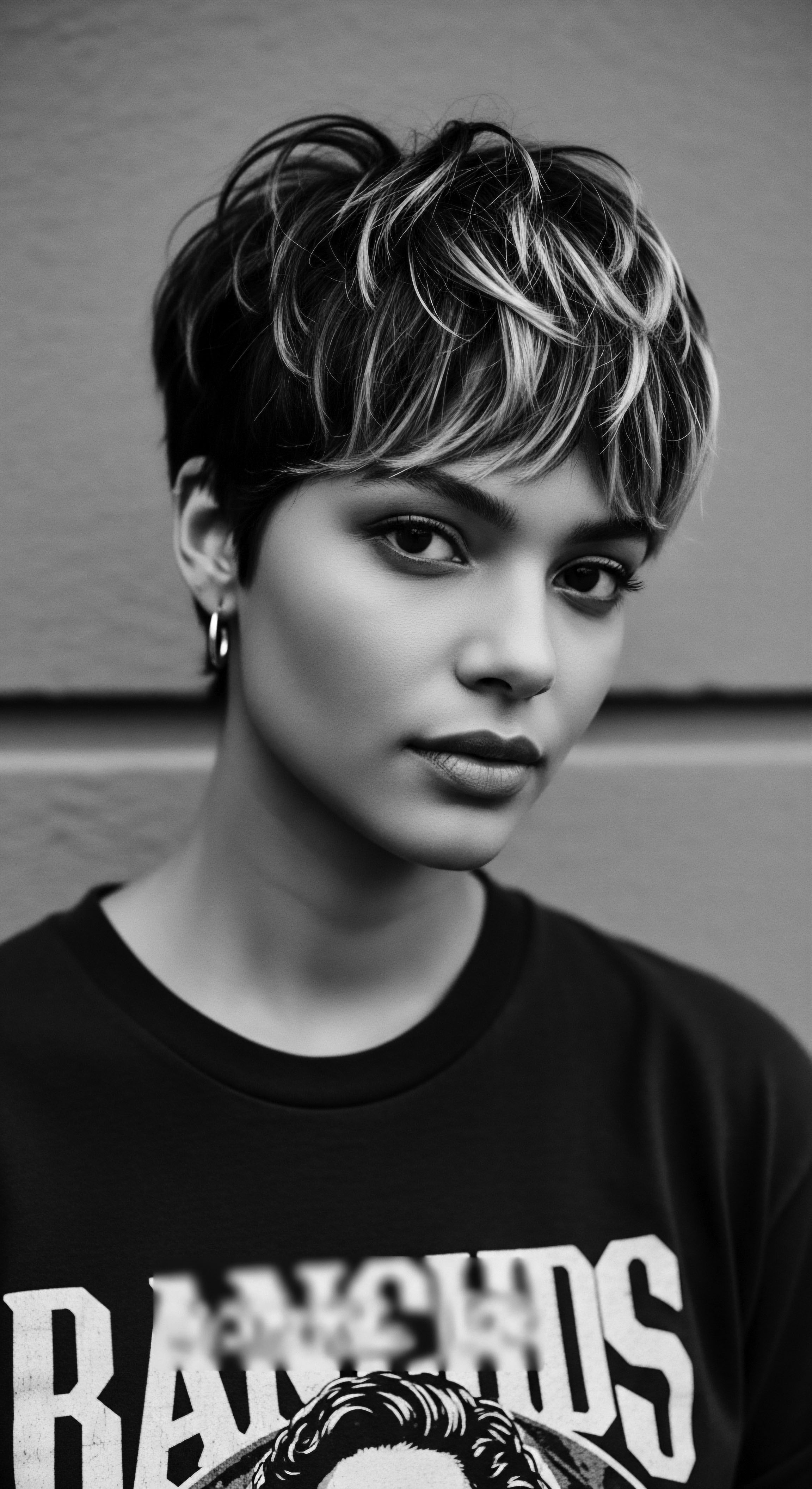
Roots
The very strands that crown our heads hold whispers of epochs past, a living library of heritage etched into their coiled form. For generations, stretching back to the dawn of human adornment, Black and mixed-race communities have honored textured hair, not merely as a biological expression, but as a profound cultural artifact, a communicator of identity, status, and spirit. To inquire into what modern hair science validates ancient hair care wisdom for textured strands is to embark on a journey that respects this deep legacy, seeking echoes of ancestral insight within the clarity of contemporary understanding. This exploration acknowledges the ingenuity of our forebears, whose meticulous care systems, born of observation and communal knowledge, often align with what today’s laboratories confirm about the unique architecture of coiled hair.

Hair Anatomy And Its Ancestral Blueprint
Textured hair, with its characteristic spirals and bends, carries a distinct anatomical signature. Unlike straight or wavy hair, each strand of textured hair often possesses an elliptical cross-section, a shape that contributes to its propensity for curling. This inherent structural quality, coupled with a cuticle layer that tends to be more raised in its overlapping scales, renders textured hair particularly susceptible to moisture loss and mechanical stress. Modern microscopic studies, such as the work examining hair of normal Black Africans, confirm these observations.
Researchers noted that the hair forms a mat of tightly interwoven shafts, appearing as a “tight coiled springlike structure,” with many shafts exhibiting knots and breaks compared to hair from other ethnic groups (Khumalo, et al. 2000). This scientific lens reveals why moisture retention and gentle handling, practices central to ancient hair traditions, were, and remain, so vital.
Ancestral hair care practices, born of meticulous observation, reveal profound understanding of textured hair’s unique architecture.
The wisdom of antiquity intuitively grasped the need for hydration and careful protection. Consider the historical reliance on natural butters and oils across various African societies. Shea butter, a staple from West Africa, has been used for centuries, not just for skin, but for hair conditioning. Scientific investigation now shows shea butter to be abundant in vitamins A, E, and F, alongside essential fatty acids, enabling it to moisturize, reduce frizz, and lend softness and shine.
This aligns with its traditional role in sealing moisture into the hair shaft, a protective action crucial for textured strands prone to dryness. Similarly, coconut oil, long celebrated in West Africa and other regions, is now understood to penetrate the hair shaft more effectively than many other oils due to its specific fatty acid structure, preventing protein loss and offering remarkable strength against hygral fatigue (the repeated swelling and contracting from water absorption) (Rele & Mohile, 2003).

Classifying Coiled Textures Through A Historical Lens
The language used to describe hair textures has evolved, often carrying historical biases. Yet, deep within traditional contexts, there existed an understanding of hair’s diverse forms. Pre-colonial African societies used hairstyles to signify a person’s tribe, occupation, societal status, marital status, wealth, kinship, and religion. These intricate styles implicitly categorized and managed various textures, even if not with modern scientific nomenclature.
While contemporary systems categorize hair by curl pattern (e.g. 3A, 4C), ancient communities observed hair’s behavior, its needs, and its unique responses to care. The “shrinkage” phenomenon, where textured hair appears significantly shorter when dry than when wet due to its coiled structure, was not a scientific discovery but a lived reality, necessitating styling methods that accounted for it. Protective styles, so prevalent in African heritage, directly responded to the hair’s tendency to tangle and break if left unmanaged (Allen, 2021).
The concept of “porosity” — a hair’s ability to absorb and retain moisture — finds its validation in ancestral practices. Communities understood which hair types readily absorbed oils and which seemed to resist them, intuitively tailoring their botanical mixtures accordingly. Modern research now links hair porosity to the cuticle layer’s integrity and genetic factors influencing its structure (Evans, 2008; Johnson et al. 2020).

Echoes of Elemental Chemistry
The use of certain plant extracts and minerals in ancient hair care also finds validation in modern chemical analysis. For instance, the traditional use of clay for cleansing, observed in some African communities, aligns with its adsorptive properties, gently drawing impurities from the hair and scalp without stripping natural oils. This is a far cry from harsh sulfates found in many contemporary shampoos that can be overly aggressive for textured hair.
Honey, a natural humectant utilized in ancient Egypt and other civilizations, demonstrates its ability to attract and hold moisture, a property crucial for combating dryness in coiled strands. Its rich sugars and minerals indeed serve as an emollient and conditioner, scientifically affirming its long-held place in traditional recipes (Colomas, 2023).
The understanding of hair growth cycles, though not articulated in cellular biology terms, was evident in seasonal styling choices and dietary practices that supported hair health. Communal grooming, often lasting for hours or days, was not only a social activity but a meticulous process of detangling, conditioning, and styling that minimized breakage and promoted length retention (BLAM UK CIC, 2022). These practices implicitly acknowledged the fragility of textured hair and the need for careful, consistent attention to its life cycle, from scalp health to tip integrity.

Ritual
The rituals surrounding textured hair care, passed down through generations, embody a profound understanding of fiber integrity and aesthetic expression. These routines, steeped in cultural significance, translate directly into practices that modern hair science now explains with molecular precision. The methods of styling, the tools employed, and the very transformations hair undergoes during these heritage rituals often serve as historical predecessors to our current scientific insights into hair health and manipulation.

Protective Styling And Ancestral Roots
The practice of protective styling, from intricate braids to elaborate locs, is a cornerstone of textured hair heritage, deeply embedded in African cultures for millennia. Braids, for instance, date back to at least 3500 BC, serving as a complex system of communication and identity markers across various African tribes. Beyond their social meanings, these styles served a practical, physiological purpose ❉ minimizing manipulation and shielding delicate strands from environmental aggressors.
Modern science validates this ancestral wisdom. The coiling pattern of textured hair makes it prone to tangling and breakage, particularly during routine combing and brushing. By gathering hair into a contained form, protective styles reduce friction and exposure to external elements like sun, wind, and pollution, which can strip moisture and compromise the cuticle. This mechanical protection lessens daily wear and tear, thereby preserving hair length and reducing breakage over time.
| Ancient Practice Braiding & Locing to denote status and kinship. |
| Modern Scientific Validation Reduces mechanical friction and daily manipulation, minimizing breakage (Khumalo et al. 2000). |
| Ancient Practice Using mud & ochre mixtures (e.g. Himba people) for style and protection. |
| Modern Scientific Validation Creates a physical barrier against environmental damage (UV, wind) and seals in moisture. |
| Ancient Practice Hair threading (Irun Kiko) for length and shape. |
| Modern Scientific Validation Stretches hair without heat, allowing for length retention and reduced tangling. |
| Ancient Practice The enduring efficacy of protective styles demonstrates a profound, inherited understanding of textured hair's structural needs. |

The Science Of Natural Definition
Ancient methods for defining natural curl patterns, often involving water, specific plant extracts, and minimal heat, find their scientific basis in the principles of hydration and cuticle health. Think of traditional “wash-and-go” practices, where water was applied, perhaps with a naturally derived slip-enhancing agent, and then left to air dry. Water itself acts as a natural plasticizer for hair, temporarily altering its disulfide bonds, allowing the coils to clump and define. The added plant-based ingredients, such as those with mucilaginous properties, would have provided natural hold and moisture.
The application of natural oils and butters after wetting, a long-standing practice, supports curl definition by coating the hair shaft, reducing frizz, and sealing in the water that helps maintain the curl’s shape. This “sealing” concept aligns with modern understanding of emollients and occlusives, which form a protective layer on the hair surface, preventing moisture evaporation.
The generational insights into hair’s response to natural elements, long considered empirical knowledge, are increasingly corroborated by modern scientific inquiry.

Wigs, Adornments, And Their Enduring Role
The wearing of wigs and elaborate hair adornments also has a rich, multi-layered heritage, dating back to ancient Egypt where wigs were worn by both men and women for hygiene, status, and protection from the sun. This practice highlights an early understanding of scalp and hair protection. Wigs provided a barrier against environmental elements and offered a means to maintain elaborate styles without constant manipulation of one’s own hair. This can be viewed as an early form of “protective styling” at a macro level, allowing natural hair to rest and grow underneath.
Adornments, such as beads, cowrie shells, and precious metals, were not merely decorative. In many pre-colonial African societies, these elements were intertwined with the styles themselves, sometimes helping to hold sections of hair in place or weighing down coils to maintain a particular look. Modern stylists occasionally use similar principles, applying decorative clips or bands that serve both an aesthetic and a functional purpose in holding a style.
- Palm Fibers ❉ Historically incorporated into styles in some African communities, providing structure and extensions.
- Cowrie Shells ❉ Used as adornments, often signifying wealth or marital status in various African cultures.
- Beads ❉ Utilized across the continent to mark age, tribal affiliation, and enhance braided or twisted styles.

Relay
The generational relay of hair care regimens for textured strands stands as a testament to ancestral ingenuity, a complex tapestry of practices now increasingly illuminated by the precise insights of modern hair science. These inherited systems, often viewed through the lens of folk wisdom, display a remarkable alignment with contemporary understanding of hair physiology, biomechanics, and ingredient efficacy.

Building Personalized Regimens From Ancestral Wisdom
For centuries, textured hair care was intensely personalized, informed by direct observation of an individual’s hair behavior and local botanical resources. This bespoke approach, rather than a universal standard, reflects an empirical understanding of diverse hair needs. Modern hair science, with its focus on hair porosity, density, and strand thickness, now provides the vocabulary for this long-held customization.
A 2020 study by researchers at the University of California, Los Angeles, explored genetic factors influencing hair texture and porosity in African American women, identifying genes associated with cuticle structure and lipid production that directly impact hair porosity (Johnson et al. 2020). This research lends scientific weight to the inherited knowledge within families about what “works” for particular hair types, demonstrating a genetic predisposition for certain hair properties that ancestral practices implicitly addressed.
For instance, families might have known that one member’s hair absorbed oils readily, suggesting higher porosity, while another’s resisted, indicating lower porosity. Their care regimens, without the scientific term, would have adjusted application methods and ingredient choices to suit these observed differences.

The Nighttime Sanctuary And Bonnet Wisdom
The ritual of protecting hair during sleep, particularly with head coverings like bonnets or scarves, is a practice deeply ingrained in Black hair heritage. This is not mere vanity; it serves a crucial, scientifically defensible purpose. Cotton pillowcases, common in many households, possess an absorptive nature, drawing moisture from hair strands throughout the night. Their rough fibers also create friction, leading to tangles, frizz, and breakage, especially for delicate textured hair.
By contrast, silk or satin bonnets, or their historical equivalents like softer, tightly woven cloths, provide a smooth, low-friction surface. This material allows hair to glide rather than snag, reducing mechanical stress and preventing the disruption of the cuticle layer. Furthermore, these coverings act as a barrier, preventing moisture evaporation from the hair shaft into the environment or absorption into a cotton pillow.
This effectively minimizes “hygral fatigue,” the damage caused by repeated swelling and shrinking of the hair fiber as it gains and loses water (Rele & Mohile, 2003). The ancestral practice of covering hair at night thus directly mitigates issues identified by modern hair biomechanics ❉ friction, moisture loss, and cuticle damage.

Ingredient Deep Dives For Ancestral Needs
The selection of ingredients in ancient hair care was often dictated by local flora and communal knowledge of their properties. Many of these traditional choices are now supported by rigorous scientific analysis for their direct benefits to textured hair.
- Shea Butter ❉ Extracted from the nuts of the shea tree, native to West Africa, this butter has been a centuries-old staple. Science confirms its richness in fatty acids, vitamins A, E, and F, making it an excellent emollient that penetrates the hair shaft, seals moisture, and provides a barrier against environmental stressors like UV exposure.
- Coconut Oil ❉ Widely used in African and Southeast Asian countries for generations. Research shows its unique molecular structure, particularly its high lauric acid content, allows it to penetrate the hair shaft deeply, reducing protein loss and strengthening the hair from within. It also demonstrates antimicrobial properties beneficial for scalp health.
- Aloe Vera ❉ Celebrated in ancient Egypt and other cultures for its soothing attributes. Modern understanding points to its enzymes, polysaccharides, and humectant properties that condition, calm scalp irritation, and draw moisture to the hair.
- Honey ❉ Used for millennia in various ancient civilizations, including Egypt. Its humectant qualities, stemming from its sugar content, are scientifically recognized for attracting and retaining moisture in the hair, contributing to softness and luster.
- Castor Oil ❉ Referenced in ancient Egyptian practices. It is rich in ricinoleic acid, which is believed to enhance circulation to the scalp, thereby supporting hair growth, alongside its known moisturizing and shine-enhancing properties.

Holistic Influences On Hair Health ❉ Beyond The Strands
Ancestral wellness philosophies rarely isolated hair care from overall well-being. Diet, stress management, and even spiritual practices were seen as interconnected elements contributing to hair health. This holistic perspective, though not articulated in terms of modern endocrinology or nutritional science, presaged current understandings.
The concept of “feeding” the hair from within, deeply rooted in many traditional societies, aligns with modern nutritional science recognizing the impact of protein, vitamins (such as biotin and vitamin D), and minerals (like iron and zinc) on hair growth and strength. Dietary staples rich in these nutrients, historically consumed in African and diasporic communities, likely contributed to hair vitality.
The deep respect for hair’s connection to one’s spiritual and physical state, a cornerstone of many ancient practices, finds resonance in contemporary holistic wellness approaches.
Furthermore, the communal aspect of hair care, where grooming sessions became social gatherings (BLAM UK CIC, 2022), inadvertently served a stress-reducing function. Stress is known to impact hair cycles and contribute to issues like telogen effluvium (stress-induced hair shedding). The calming, bonding nature of these shared rituals may have indirectly supported hair health by reducing systemic stress.
| Historical Practice Communal Grooming & Social Gatherings. |
| Modern Health Connection Reduces stress, which impacts hair growth cycles. |
| Historical Practice Using traditional cleansers (e.g. clay, plant saponins). |
| Modern Health Connection Gentle cleansing that preserves the hair's natural moisture barrier. |
| Historical Practice Dietary focus on nutrient-dense foods. |
| Modern Health Connection Provides essential vitamins and minerals crucial for follicular health. |
| Historical Practice The comprehensive nature of ancestral care extends beyond topical application, acknowledging the internal and communal dimensions of hair well-being. |

Reflection
To delve into what modern hair science validates ancient hair care wisdom for textured strands is to walk alongside a profound historical current, one that honors the enduring wisdom of those who came before us. The unique structure of coiled hair, a gift of adaptation, required early ingenuity in its care. Generations applied knowledge, observing, refining, and passing down rituals that intuitively addressed the very challenges modern science articulates with precision. The ancestral use of rich oils and butters, for instance, finds its mirror in today’s understanding of lipid barriers and moisture retention.
The protective styles, once identifiers of tribe and status, are now recognized for their mechanical brilliance in guarding against breakage. Nighttime coverings, born of comfort and care, prove scientifically sound in their ability to minimize friction and preserve hydration.
This is not merely a validation of the past by the present; it is a profound testament to the resilience of knowledge, sustained through lived experience and cultural continuity, even in the face of immense historical disruption. The practices of Black and mixed-race hair heritage stand as a vibrant, living archive, offering invaluable blueprints for holistic well-being and beauty. The soul of a strand, in every coil and kink, holds the whispers of ancient hands, an ongoing conversation between deep history and unfolding discovery. This journey into textured hair heritage is a celebration of enduring wisdom, reminding us that the path to radiant, healthy hair is often found by listening to the echoes from the source.

References
- Khumalo, N. P. Doe, P. T. Dawber, R. P. & Ferguson, D. J. (2000). What is normal black African hair? A light and scanning electron-microscopic study. Journal of the American Academy of Dermatology, 43(5 Pt 1), 814–820.
- Rele, V. J. & Mohile, R. B. (2003). Effect of mineral oil, sunflower oil, and coconut oil on prevention of hair damage. Journal of Cosmetic Science, 54(2), 175-192.
- Allen, M. (2021). Braids, Plaits, Locs ❉ The History of Black Protective Hairstyles. Royaltee Magazine.
- BLAM UK CIC. (2022, September 15). The history of Black Hair.
- Colomas, J. (2023, December 2). Unlock Ancient Hair Care Secrets ❉ Discover Global Rituals for Lustrous Locks. Joanna Colomas.
- Johnson, D. et al. (2020). Genetic factors influencing hair texture and porosity in African American women. Journal of Cosmetic Science (Specific journal and full citation not provided in snippets, but referenced in from University of California, Los Angeles study).
- Evans, T. (2008). Adsorption Properties of Hair. Journal of Cosmetic Science.
